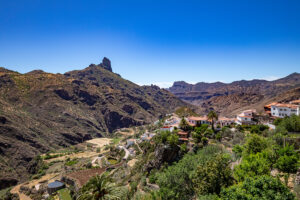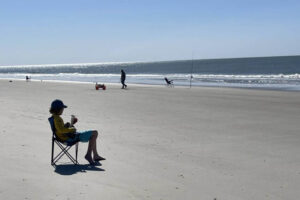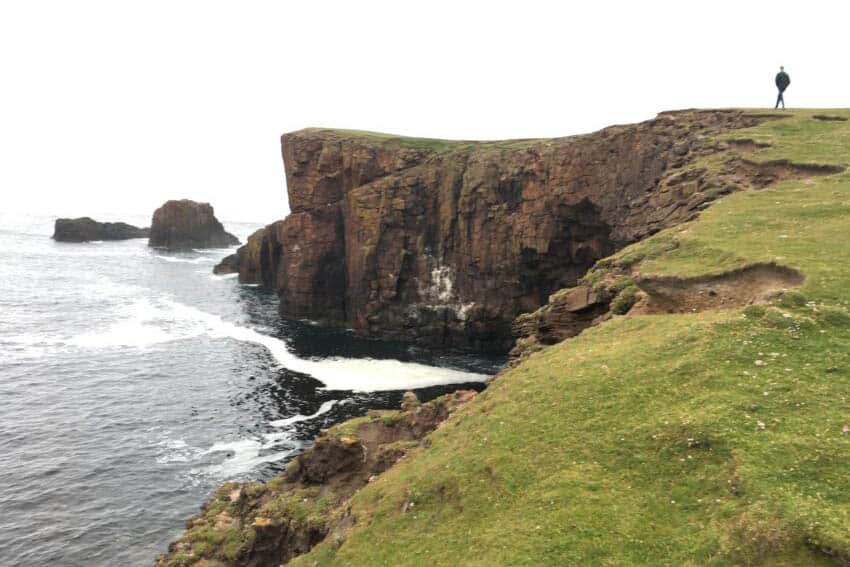
By Gary Joyce
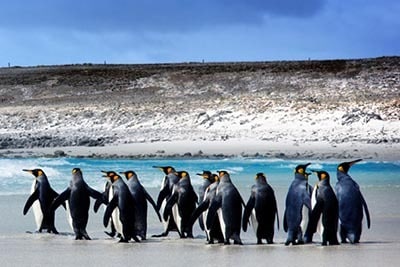
WHERE
A collection of 420 islands, most uninhabited, in the South Atlantic Ocean off the east coast of Argentina. The islands occupy a space some 160 miles (west to east) by 85 miles.
WHY GO
Most people are familiar with the Falklands as a result of the 1982 British-Argentinean battle. Reminders of the war linger — a huge memorial in Stanley, military graves and memorials in remote sections like Goose Green, San Carlos, Sea Lion Island, and others.
Lesser known is the Battle of the Falklands: the islands were the site of the defeat of the German Navy by the British during World War I. A memorial on the west end of Ross Road, Stanley’s main street, commemorates this event as well.
Aside from the fact that the name continues to be a toss-up to cartographers (The Argentineans still aren’t really happy with the way that little incident called the War of the Falklands turned out), there is more adventure to be had walking around the only “city” — Stanley — than there is on any seven-day trek anywhere.
With 2,700 people spread out over 645 square miles of some 420 islands, you’re talking about some seriously empty space. REAL adventure territory. If I could, I’d move there tomorrow. At least for 10 or so years. It should take that long to tire the boundless adventure possibilities.
Nowhere else can you walk right up to elephant seals, dive hundreds of wrecks (some you can walk right up to as well), sea kayak with orcas, talk with penguins, experience every conceivable type of weather possible in one eight-hour day, fish salmon from untapped streams, 4×4 miles and miles of empty-save-for-sheep land, visit battle sites, see birds you’ve only dreamt about and much more. You also will get to experience some of the wildest — and best — bush flying this side of Alaska.
WHEN TO GO
The Falklands are in the southern hemisphere, so their winter is our summer and vice versa. Try late January to the beginning of March, but bring clothes for snow, rain, wind, sun, etc., etc., regardless.
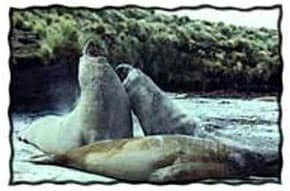
Man, woman or child, every Falklander lives with the wind. From the west or northwest, it’s blowing off South America… a warming wind.
From the east, it’s out of the deep unobstructed South Atlantic, and that means storms and rain. And from the south? Brrrrr. Antarctica is just over the horizon.
Eighty-knot winds are no big thing (daily wind speed average is 16 knots) and as a result, the locals have a rather odd conceptual grasp of what wind is; i.e., “It’s only blowing about 30 knots, mate, we’ll find a place to dive.”
We did, of course, but we had to wear our dive masks topside en route to the dive site. Insane, but worth it.
GETTING THERE AND AROUND
By Air
Getting to the windy Falklands isn’t always a breeze. You can’t fly in from Argentina (except once a month from Rio Gallegos), so you have to depart from Santiago, Chile, down to Punta Arenas, and then over to the Falklands. Take Lan Chile out of the US (American, and United, as well) to Santiago. The weekly Lan Chile flight from Santiago to the Falklands departs Saturday AM. Interior Chilean Air also flies to Punta Arenas, where you can pick up the Lan Chile flight.
I flew DAP from Punta Arenas to Mount Pleasant Airport (MPA) in the Falklands, the only point of air entry, and a quite active and armed military base.
A weekly RAF Trident makes the flight from the U.K. via Ascension Island and into the Falklands as well. Flights in and out are limited: you’re going to spend a minimum of seven days in the islands regardless of how long you wish to stay.

GETTING AROUND
Most internal travel is by 4×4 (usually “real” Land Rovers), horse, foot or motorcycle. FIGAS (Falkland Island Government Air Service) runs nine-passenger Islander prop planes with the best pilots I’ve ever seen (and I’ve seen a few); most airfields are grass/dirt strips. When your pilot notes, “It’s quite lumpy today, so keep your seat belts quite tight,” do what he says.
FIGAS passenger lists are announced every evening on the local radio at 7 p.m. You listen for your name to be called.
Rental 4x4s are available in Stanley.
BEST MAJOR ATTRACTION
There are 21 government-owned sanctuary islands, plus another 34 privately-owned preserves. All require permission to get to. If you find an abandoned-looking hut on any of them, they were built for shipwrecked sailors.
- Sea Lion Island
Birds, birds and more birds, a delightful resort and an easy walk-up to two-ton elephant seals beating the hell out of each other. (Hint: when you encounter herds of gentoo penguins on the beach lie down…they’ll walk up to you.)
BEST UNUSUAL ATTRACTION
Almost all the attractions in the Falklands are unusual. Believe me, there’s just so much to see that you’ve never seen before in the Falklands. Just a few to give you an idea:
- The par three on a nine-hole course in Goose Bay
Watch the rough, it’s mined.
- The cemetery in Stanley
Spend a couple of hours reading of shipwrecks and horrendous sea and land disasters.
- Talk to the EOD (Explosive Ordinance Disposal) British Army guys in Stanley
It’s a full-time job, courtesy of the Israeli and Spanish plastic knock-offs of traditional mines the Argentineans used that keep surfacing. They’ll be happy to show you around their HQ.
The islands are virtually treeless. Some bush-like trees have been imported to Stanley and taken root in the thin soil, but over the rest of the 4,600 square miles, tussock grass — a bladed shrub that grows some 10 to 12 feet high out of individual pedestals/hummocks — reigns supreme. You can meander along the bases of the tussock and get nowhere real quick, or you can walk atop the hummocks and get really tired, your choice. How anybody fought a war in this stuff is beyond me.
BEST ACTIVITY AND TOUR
If you’re a diver and your cold-water, drysuit, small boat and heavy weather skills are up to par, go diving. Decent visibility (can go as high as 40 feet; expect much less); dolphins (Commersons and Peale’s), really nosy seals, wrecks, wrecks, wrecks, and more wrecks, plus you never know what else will come in from the deep. There is now an operational decompression chamber on-island.
If icy diving isn’t your thing, take a 4×4 overnighter out to San Carlos Waters and stay at the Blue Beach Lodge (as if you had a choice!) for the “yomp” (Falkland-ese for taking a hike in the boonies), history, scenery and salmon fishing. Visit the war graves, kick up pieces of shrapnel. The owners of the Blue Beach are incredibly nice, and you’d swear you just stopped in for a cuppa’ in a small English village.
Check out Ajax Bay, where a former abattoir — slaughterhouse — served as a British field hospital during the “troubles” (as Brits everywhere refer to their pocket wars). Interesting graffiti on the walls, but I don’t think a slaughterhouse would be on your “A” list of places to die.
If geology is your bag, see if you can figure out the stone runs — river-like courses of huge granite blocks. The best explanation of the phenomenon is that it is the result of glaciation, melt, mud atop ice, glaciation, melt, etc. ad nauseam: no one’s really sure. From the air, the stone runs look like rivers meandering down hills and through moonscape valleys.
- One of the best sources for overland, on water, or above water adventure is South Atlantic Marine Service.
Tel: +500-21145, fax: +500-22674
sams@horizon.co.fk
They offer 4×4 tours, diving, naturalist tours, fishing tours, etc.
There are a few others offering some of the services (especially 4×4 rental and land tours).
BEST ALTERNATIVE
Walk around Stanley. You’ll find plenty of stuff to do. Walking the cliffs out of town, watch out for big, seriously pissed-off southern sea lion males without harems (that’s why they’re pissed off). You will smell them first if the wind’s blowing in the right direction. If not, keep your ears open. Pay attention to the “mine” signs wherever you go: you never know.
Hang out at the port like a local when some of the “adventure” cruise ships pull in for the day. Makes you feel really rugged. And, once, I actually met someone who knew someone, who knew someone that I … six degrees of separation, et al.
BEST LODGINGS
There are some half-dozen hotels and inns in town, all in the classic small-town English style, complete with darts and bitters in the bar, Union Jacks, soccer club cups, etc. The rooms are a bit drafty but neat, clean and cozy (as in small). Don’t be surprised if someone offers you a spare bed in their home, or invites you over for dinner (You do like lamb, don’t you?).
- Upland Goose Hotel
Tel: +500-21455; fax: +500-21520
- Malvinas House Hotel
Tel: +500-21355; fax: +500-21357
BEST EATS
Your only options outside of a home-cooked meal and a bakery treat are the few taverns and restaurants in Stanley. The fare is, well, British, and mutton is ubiquitous, but servings are usually quite filling, and prices are generally reasonable. Pub food is the best bet.
BEST LOCAL HAUNTS
What taverns there are can provide some interesting company. From barmaids from Tristan de Cunha, to British Antarctic Survey personnel, to shipwrecked round-the-world soloers, to Texas and Aussie oilmen, to Korean squidders, to … who knows who will walk in the door. Makes for very lively conversations.
BEST SHOPPING
Stanley has every shop your usual small city has: hairdressers, doctors, lawyers (barristers), school, supermarket, bakery, haberdashery, hardware, etc. The products are British and the prices aren’t terribly dear (as the locals would say); the Falklands are, after all, part of the British Empire.
VISAS AND DOCUMENTS
The Falklands are still part of the British Empire, so unless you need a visa for the UK, you don’t need one for the Falklands. But because you have to pass through some other countries to get here, you may need visas for other stops.
No immunizations are required, but it’s always a good idea to get the standard ones since you’ll be coming from Latin America. Water is drinkable (and cold!).
There is — aside from the occasional tavern brawl — no crime to speak of.
As for clothing, make sure to bring to a warm, Goretex (or equivalent) coat, dress in layers and wear good waterproof hiking boots. Bring wind and rain gear — you’re going to need it.
MONEY AND COMMUNICATIONS
The currency is based on the UK Sterling. The local bank is a UK affiliate and can usually assuage your cash needs. Travelers’ checks and cash are better than credit cards.
The country Code is 500. Best communications are by fax, though e-mail has been in for the past couple of years.
BEST RESOURCES
Falkland Islands Tourist Board
Fax: +500 27020
email: tourism@horizon.co.fk or jettycentre@horizon.co.fk
website: visitorfalklands.com
Falkland Tourism
Tel: +500-22215; fax: +500-22619
email: tourism@fidc.org.fk
website: tourism.org.fk
The best book to read is Battle for the Falklands by Max Hastings and Simon Jenkins. It’s military history and well-written for what can be a quite dry genre. The book will give you an excellent idea of just what the Falklands are all about. Amazon.com carries it and a (very!) few others on the islands.
- Saudi Arabia Might Be Your Next Getaway Spot - April 23, 2024
- Mongolia, the Land of Eternal Blue Sky - April 20, 2024
- These 9 U.S. National Parks Require Reservations in 2024 - April 17, 2024



